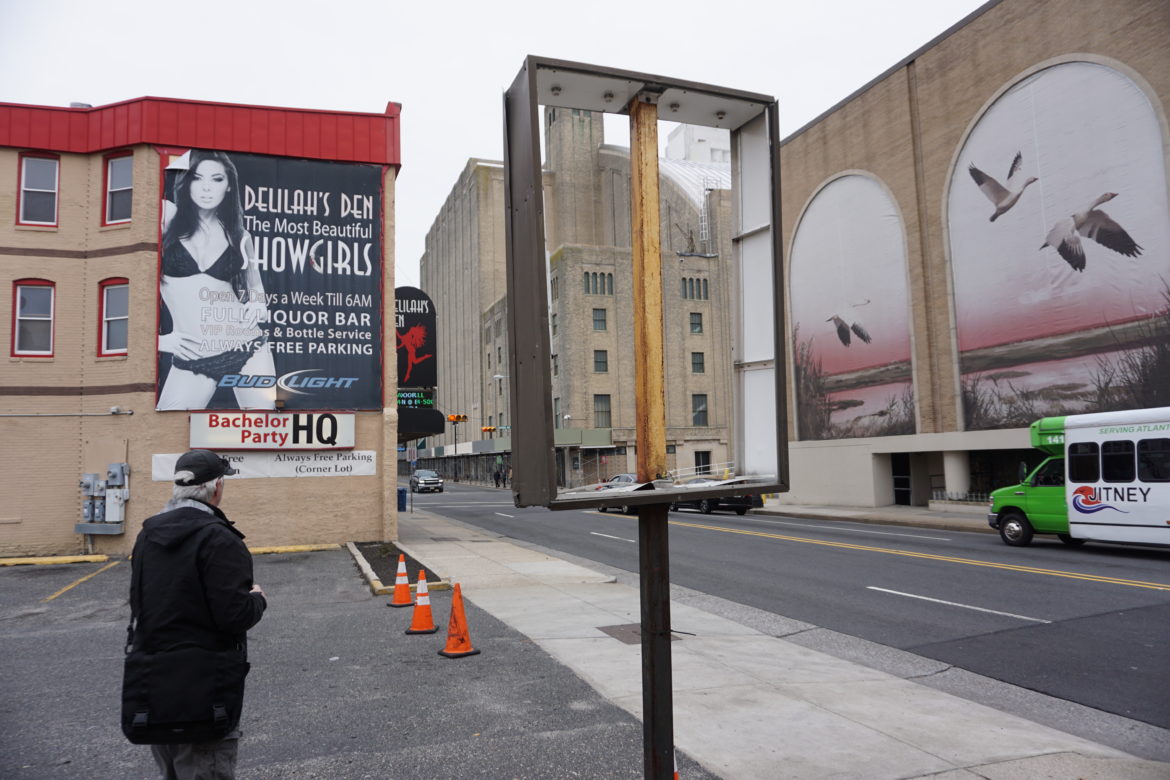The photographer Brian Rose drove to Atlantic City in a Zip car from New York in November 2016, not long after the election. He started taking pictures around town with a Wanderlust Travelwide 4×5 camera to which he’d attached a 90mm Schneider lens, second-hand, which is a medium-wide lens on a view camera, Rose says.
On an early visit, in the winter of 2017, he estimates, he set up in the South Inlet in the vicinity of Rhode Island Avenue and pointed his camera at the Revel casino. With the Travelwide, he uses ISO 400 film (relatively slow) and a narrow aperture to get depth of field, so even in bright sunlight he has to shoot at slow shutter speeds — slow enough that camera shake can be an issue, even without the insistent winds of the South Inlet.
One photograph he took shows two small apartments standing athwart the casino, an American flag waving in a yard nearby, a big red trash container, wheels-up, sitting in the foreground. The wall is cut by a diagonal line. A blue sky, mottled by clouds, reflects in the glass. Rose can’t remember if he used a tripod or not for this particular shot, but the image was perfectly sharp, he said, so it worked.
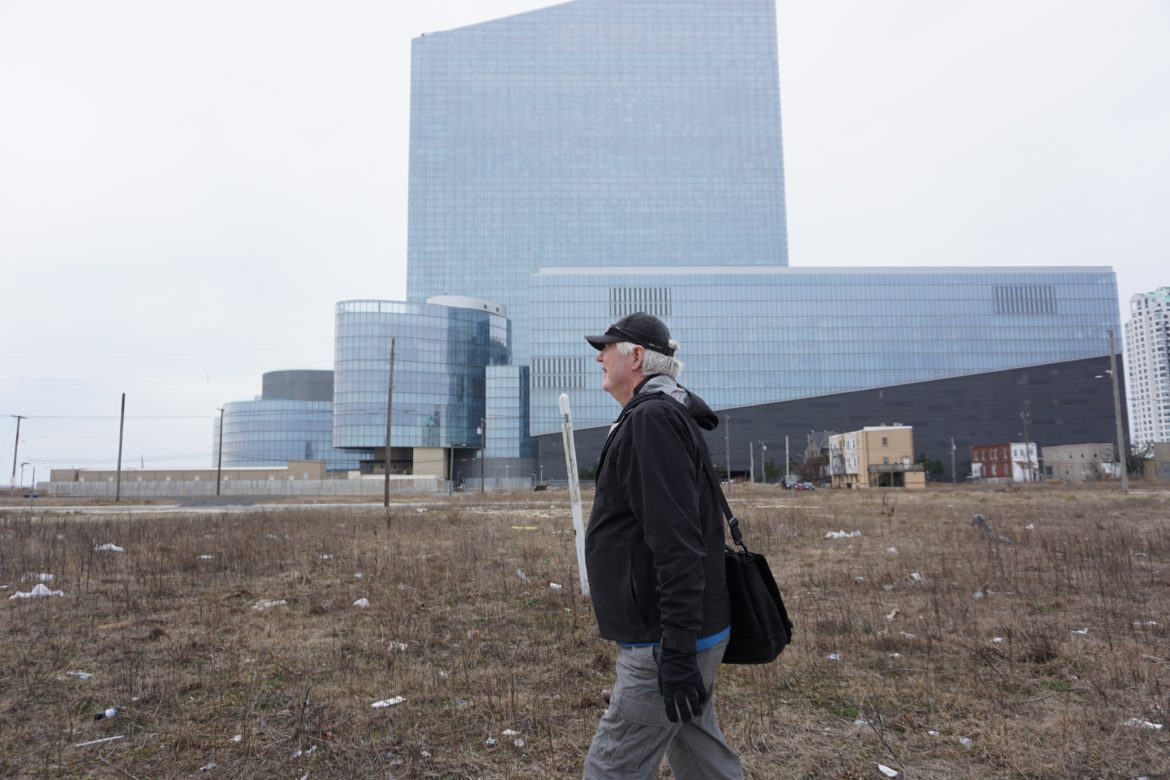
Photographer Brian Rose, in the South Inlet
Pictures of the Revel from Metropolitan Avenue have been a staple of Atlantic City storytelling since the casino was built, but Rose’s differs from most in that it shows only a fraction of the 718-foot hotel tower, which, it turns out, only magnifies the sense that something is looming like a tsunami over the hopeless little apartments, where a 28-year-old, Steven Loughney, was murdered in his house by a man with a shotgun in January 2016.
Not long after he took the picture, Rose submitted it to a contest for architectural photography. Ordinarily, he said, he would not have bothered since those things never work out and are usually just money-makers for the organizations, but this was run by a group he respected, and it was coming at moment when work that was “a little political might carry a little more weight,” he said recently.
Rose was shortlisted for the award and flew to London for a showing of the finalists’ work, where he ended up seated at dinner across from the publisher, David Jenkins, who had voted for Rose’s shot of the Revel. They had a rapport. After a few meetings, Rose had a publishing agreement. The book, Atlantic City, was published by Circa Press, on March 1. The picture of the Revel is on the cover.
Weirdos like me who have longed for a transcendent visual talent to document our municipality’s insane vacant lots will rejoice at this book’s arrival. (I’m not sure how many others will.)
Of the 58 photos in Brian Rose’s Atlantic City, 28, by my count, are primarily concerned with vacant lots. Five of those 28, you could argue, are really parking lots that happen not to have cars in them, but some of those parking lots, I suspect, are attached to businesses or houses that are themselves thoroughly vacant. Have your accountant call my accountant if you really want to bicker over the statistics.
It would be dishonest of me to pretend I appreciate Rose’s photography per se. I am a visual idiot and entirely ignorant of the arts. But by dumb chance I have taken enough pictures around Atlantic City (often from the same vantages Rose did) to form a dim sense of the magnitude of his achievement. That he got these shots on film using a camera that doesn’t even have a viewfinder is a deeper mystery to me. But the 4×5 produces a clarity you could not get with digital without spending tens of thousands of dollars, Rose said. The Wanderlust was $149 plus whatever he paid for the lens. So that’s kind of awesome too.
Rose’s photographs unfold beside a series of quotations about Atlantic City, pulled from the research Rose collected when he wasn’t taking pictures. “Lou Pascal,” the Burt Lancaster character from Louis Malle’s Atlantic City, appears twice in the first two pages. Local readers will recognize the bylines of Amy Rosenberg (The Philly Inquirer), Nick Huba (The Press of AC) and Wayne Parry (Associated Press). The Jitney Guy makes a cameo, as does Reuben Kramer (formerly of the Press). There are snippets from Martin Scorsese, David Byrne (The Talking Heads) and the website of the Knife & Fork Inn. But Rose also pulls in the big journalistic guns—The New Yorker, The Washington Post, The New Republic—who have visited the Atlantic City question in recent years. His is probably the only book of Atlantic City photography to cite at length a director at FinCEN. Sometimes the quotes come from the President of the United States.
Rose identified seventeen Atlantic City tweets from POTUS over the years, he says. I count sixteen that appear in the book. They are redundant, even by Donald Trump standards. Donald has nothing (“NOTHING”) to do with Atlantic City, he wants us to know — made a lot of money and got out a long time ago. Often (six times), he congratulates himself on his “timing” while suggesting, falsely, that Atlantic City’s decline is somehow connected to his departure.
As usual, Donald is throwing so much bullshit it’s hard to keep your head straight. If you condemn him, for instance, for extracting a lot of wealth from Atlantic City and leaving it bankrupt, you risk accusing him of being a good businessman, which of course he is not. You also elide the grimmer reality that Atlantic City was poor before Donald Trump, poor when he was the largest casino operator in town and poor now that he is president.
A few longtime reporters on the Trump beat have noted the president had little, if any, equity in his Atlantic City casino projects, questioning whether Donald was ever really in Atlantic City in the first place. By 2014, he was renting the use of his surname — always an effective sucker magnet — to Trump Entertainment Resorts, the company he’d lost control of to his “friend” Carl Icahn whom he had to sue to have the name erased from the Trump Plaza, since that property was so thoroughly befouled it was beginning to hurt Donald’s salary prospects at his actual day job (playing a TV billionaire on “The Apprentice”). So that’s what Donald means by “timing.”
Rose devotes some space to the Russia connection and Donald’s many crimes. In his view, the Trump Organization was a criminal enterprise from its early days. At one point he finds a pack of cigarettes on the beach with Cyrillic letters on it.
“I thought reflexively, ‘The Russians are coming!’ But the Russians are already here,” he writes.
Maybe it’s because I live and work (kind of) here, but the media focus on the crimes is one of those things that maps awkwardly onto the Atlantic City experience.
Donald’s criminality is galling, of course, and dangerous to the humanity given his ascension, but I’m not sure he was any more damaging locally than Carl Icahn, for instance. Icahn gets to lay off thousands of workers, cut healthcare benefits and shake down the CRDA for millions of dollars to demolish the Plaza, and he still gets the CNBC good-businessman’s seal of approval.
Good-governance capitalism has not been kinder to Atlantic City than bossism or cronyism or the brazen illegality of earlier eras. If anything, the modern, corporate gambling economy is a more efficient digestive tract for sucking up local surpluses and depositing them in the bank accounts of distant shar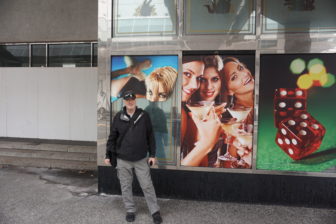 eholders.
eholders.
On page 90 of the book, Governor Brendan Byrne announces (half-jokingly probably) it was his mistake to keep the mob out of Atlantic City.
“They know how to run casinos,” Byrne says.
At least they laundered their money locally.
**
There are not many people in Atlantic City, and those few who do appear — a man with a cane walking down an alley, a guy riding a bike down Pacific Avenue — are often overwhelmed by their surroundings. This too feels grounded in the facts.
It’s not that Atlantic City is a ghost town — far from it — but the blank walls and parking lots do a good job hiding the humans from each other. The biggest people in Rose’s book are the models on the walls. They are advertisements for closed casinos.
One photo shows two guys feeding the cats that live under the boardwalk in front of the Taj Mahal (before it was de-Trumped). Something about their postures, the way their jeans fit, the white running shoes, feels familiar.
But my favorite bits of Atlantic City are the empty lots. Rose shows us the abandoned beach volleyball courts between Showboat and the Revel, the source of so much tension between the casino owner neighbors. They are beige, the courts. Why are there weird lines all over the wall behind them? The whole thing makes no sense.
We see trees painted on a blank wall along Snake Alley, parking bumpers crumbling beneath them, the ramparts of the Knights Inn Motel (Free HBO), across the street from a hundred-year-old church, across the street from Hard Rock. The Baltimore Grill sits next to the big Tropicana, also beige. In one photo, Miss America, her statue anyway, holds a crown beside some port-o-potties while tourists take selfies.
You have walked past these places many times. Perhaps you have wondered at them as well. It is good to see someone shares your sense of strangeness.
Rose worried his photos would be perceived as a hit job on Atlantic City. He was not into “ruin porn” of the kind sometimes produced around cities like Detroit. “Photographers,” he said, “they get all excited about places that are run down and decrepit because it shows up really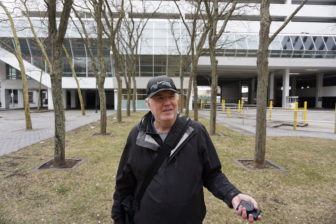 well in pictures. The problem I find, with a lot of that, is, for what purpose is this?”
well in pictures. The problem I find, with a lot of that, is, for what purpose is this?”
In Atlantic City, a purpose is obvious: the guy in the White House with the twitter account.
Rose asks in his introduction whether there is something emblematic in Atlantic City that may be applicable to the wider world. I wonder if there is not also something emblematic in the idea, on display in 2016, that showing people Atlantic City would be an effective deterrent to the election of Donald Trump. I think of that Hillary Clinton speech in front of the Trump Plaza in 2016, when the party field-tested the idea that if voters saw Donald’s handiwork, you maybe trotted out a few aggrieved contractors, America would recoil from this possible future. In the event, even Atlantic City suburbs like Absecon, Northfield and Linwood — every bit as economically dependent on the casinos than the city is — voted for Trump.
**
The Atlantic City in Rose’s book is strange, maybe even beautiful at times, if also beat up. The motels look old. The cars are old. Part of this may be Rose’s technique—4×5 film looks alien when you’re accustomed to digital super-cameras and Instagram filters. Part of it is the very real effect of decades of disinvestment. Either way, readers seeking insight into America’s future in Atlantic City may be surprised by how much it looks like 1991.
But the future, as William Gibson says, is not evenly distributed. We got the old cars and motels. You got our guy as president.
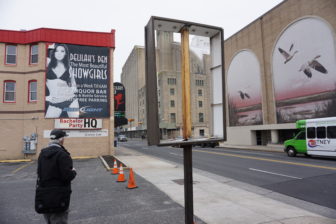
Brian Rose, outside Delilah’s Den
A few weeks ago, before the book came out, Rose came down to Atlantic City and we stood in the parking lot next to Delilah’s Den, the strip club on Pacific Avenue, to revisit the scene of another photograph. Rose mentioned Giorgio de Chirico, the Italian proto-surrealist (I had to look him up) painter.
In the book, Rose’s photo of Delilah’s appears beside a Trump tweet where Donald says he’d absolutely consider investing in Atlantic City again someday— “great and hard working people” (?). It shows the side of the strip club, with Boardwalk Hall in the background and the top of the Plaza just visible behind it. For some reason geese, on a colossal scale, flap across the wall of the power plant. They seem to be emanating from the big sign advertising free parking at the #1 gentlemen’s club in America, open 7 days a week until 6 a.m.
“Boardwalk Hall is very austere, but it’s also a really, really magnificent structure, and it’s in pretty good shape. But then you have these…it’s like. You have this over here with the geese. Then you have the Delilah’s over here. And it’s like, what the hell is this about?”
The surreal thing is Atlantic City really looks like this.
